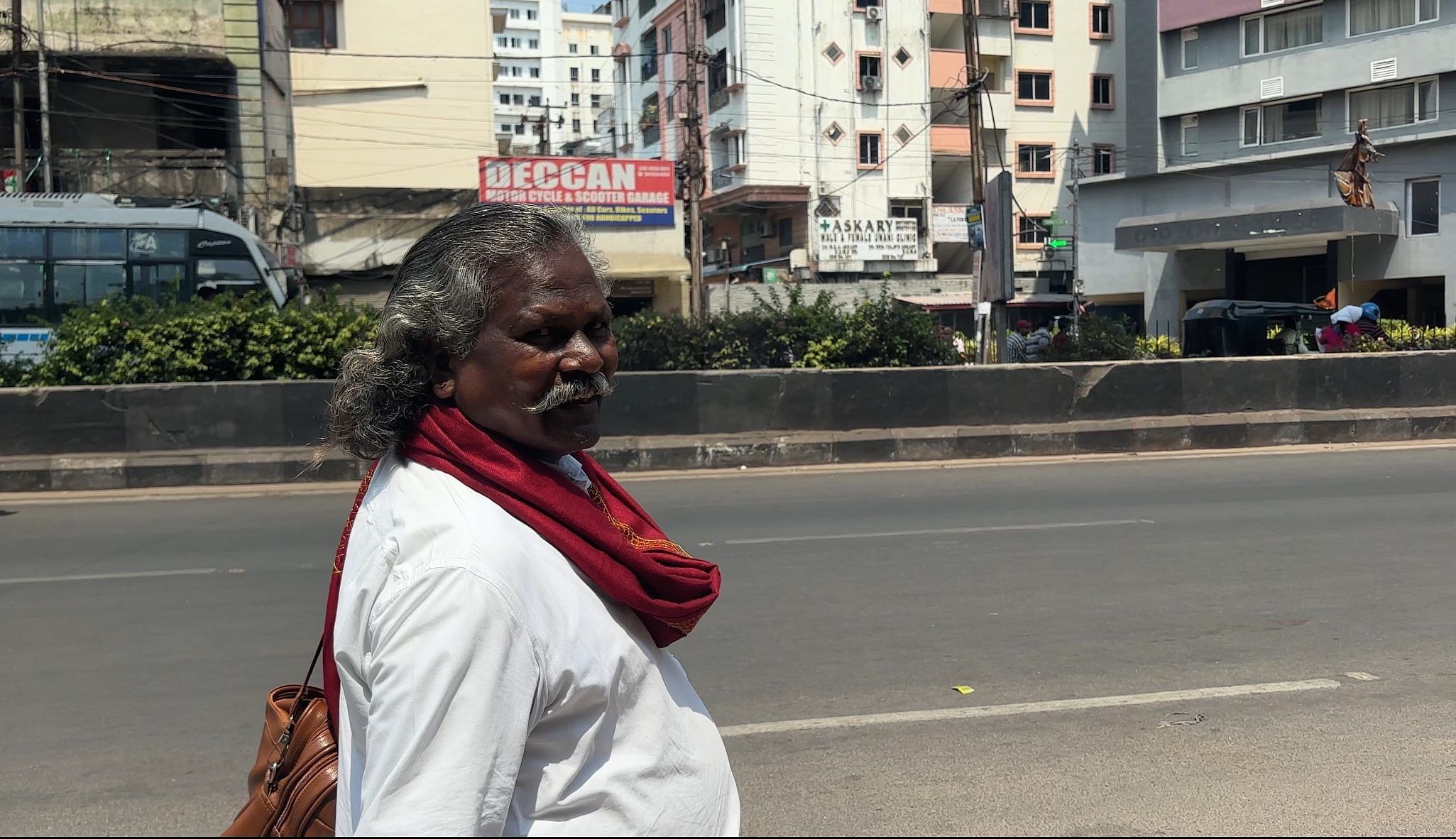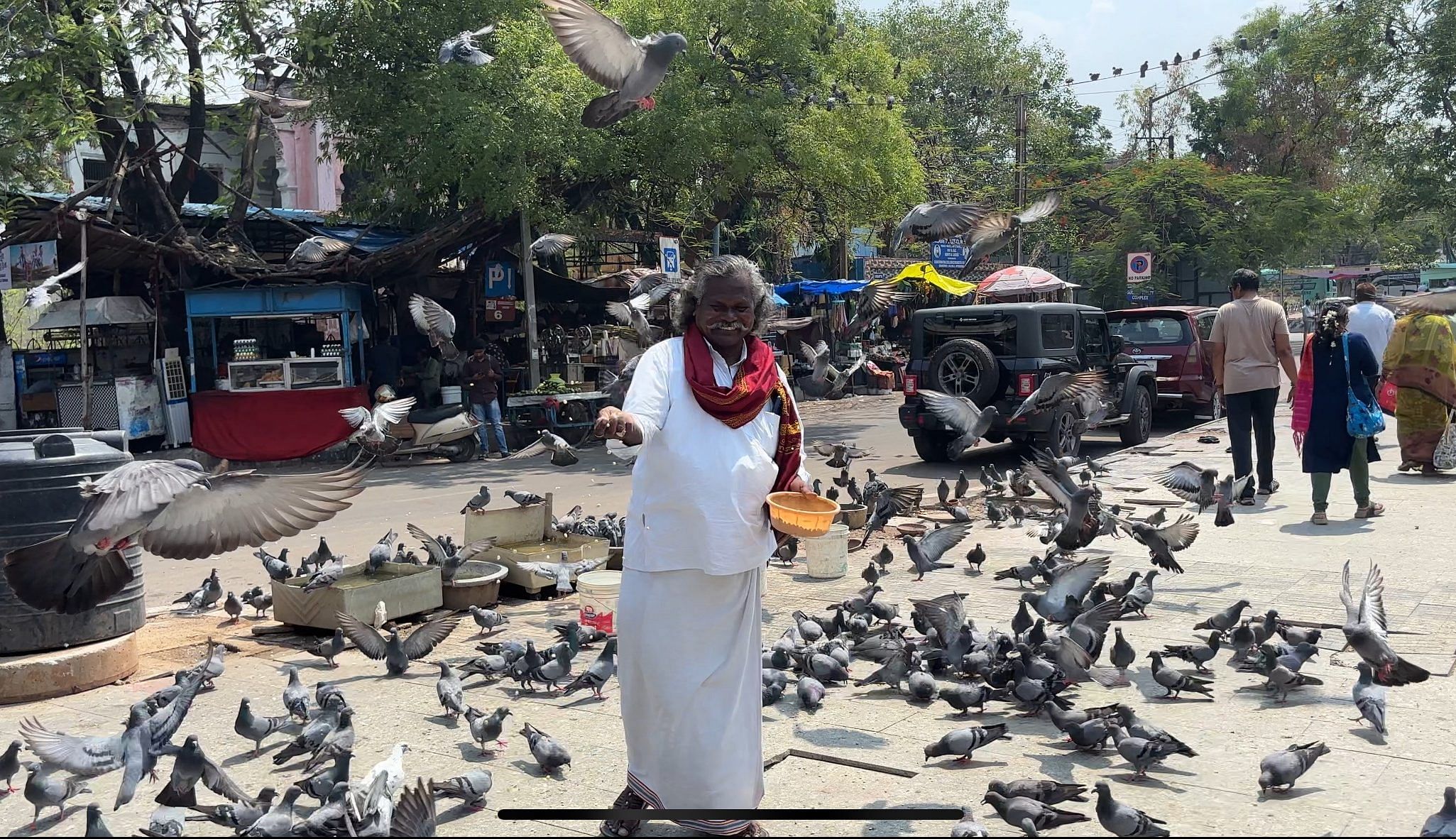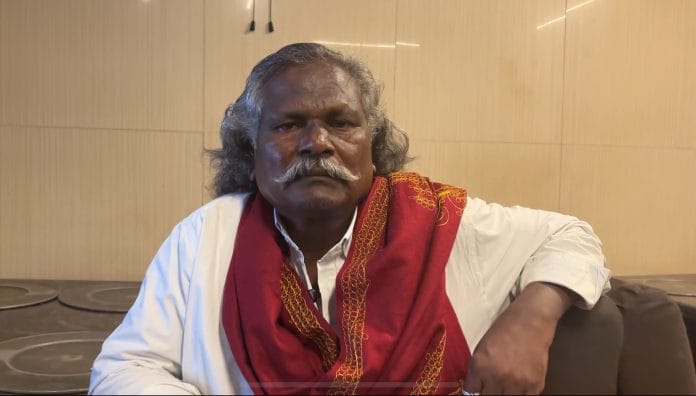Hyderabad: Padma Shri Darshanam Mogilaiah is embarrassed — life hasn’t exactly gone to plan for the kinnera artiste since he won the award two years ago.
Easily recognisable in his signature maroon shawl draped over his white shirt and mundu, Mogilaiah is a mini-celebrity in Hyderabad. He can barely walk ten metres without someone shouting his name or singing Pawan Kalyan theme song. He stops and indulges each person — from auto drivers abruptly veering away from traffic to grab a selfie to women at bus stands curious about what he’s doing in the hustle and bustle of Hyderabad.
But what the 69-year-old doesn’t tell them is that he is financially struggling. His fame has not led to fortune. His story hasn’t turned out much differently from Olympian Sita Sahu, who was forced to sell gol gappas, or medallist runner Meraj Ali, who loads crates of milk. News reports of such champions spotted living in penury are often followed by public moral outrage, some political platitudes, and then nothing.
“People always come and take photos of me — police, politicians, everyone. Even the doctor I just met took a photo with me,” says Mogulaiah, whipping out his phone and scrolling through photos. “But what use is that? I get only daya (pity), not paisa (money).”
Around ten days before the 2024 Padma Shri awards were presented on 9 May, news broke that the folk artist was working at a construction site as a daily wage labourer to make ends meet. The truth is that Mogilaiah, who won the award in 2022, has never been able to make a living from his art — and a spate of health problems in his family has further weakened him.
People always come and take photos of me — police, politicians, everyone. But what use is that? I get only daya (pity), not paisa (money)
Mogilaiah is the only remaining kinnera player in India today, and the stakes are high. His hopes are pinned on his son to carry on not just his family’s legacy but also an almost-extinct indigenous art form. However, for his son Mahender to do so, he needs to be on strict medication — because he suffers from regular seizures.
In fact, Mogilaiah is in Hyderabad for the day only to visit a doctor and pick up medicine for his son. He rummages in his brown canvas bag and pulls out various medicines, spreading them across a restaurant table.
“My instrument is at home in my village, and this is what I carry with me instead,” he says, gesturing at the tablets in front of him.
Financial trouble
Mogulaiah isn’t just the only last remaining kinnera player — he has also reinvented it.
The indigenous string instrument is traced back to tribal and Dalit groups like the Madigas and the Chenchus. Similar to the veena, the instrument has traditionally been made using materials like bamboo, dried bottle gourd, and honeycombs. A gory anecdote offers a possible explanation for why the Chenchus stopped playing the kinnera: a Chenchu woman, lost in the grips of its music, accidentally cut up her infant while cutting vegetables. Horrified, the tribe outlawed the instrument from their hills.
But Mogulaiah doesn’t concern himself with this cultural provenance; he has a personal connection to the kinnera. The fifth-generation folk artist has been playing the instrument for almost sixty years, singing folk tales of heroes and battles — one of his favourites is a ballad about Panduga Sayanna, a man known as the ‘Telugu Robin Hood.’ His forefathers have significantly updated the kinnera — replacing strings made with women’s hair and animal’s nerves with metal strings.
But all his life, Mogilaiah has balanced his art with odd jobs. He has worked as a labourer at construction sites for 25 years in places like Karminagar, Turkapally, Medak, and Warangal, even venturing as far as Mumbai for more work. He would work by day and sing by night — because there is no money in his art, he says.

“That photo of me was taken a month ago,” explains Mogilaiah, referring to the viral photo of him working at a construction site. “I got some work for a few days. But it’s extremely rare to get such work. I have a big name now, so no one gives me work.”
Since the photo went viral, Mogilaiah has met both Chief Minister Revanth Reddy and BRS leader KTR. Reddy directed Konda Surekha, Telangana’s Minister of Environment and Forest, to look into the matter and address his concerns — promising a pension of Rs 20,000. KTR also met Mogilaiah and told him that a man of his stature should not be working at construction sites. He promised to look into why his monthly honorarium of Rs 10,000 was stopped and arranged for some money to be transferred to his bank account, according to the folk artist.
While Mogulaiah still receives invitations to perform, he isn’t paid much. The art form is mostly appreciated by rural people like himself, and they don’t have the funds to pay him — so he doesn’t expect much remuneration, he says. The only major money he made from the kinnera is when composer Thaman paid him to perform the theme song for a Pawan Kalyan film — the sound of the kinnera and the folk song he sang suited the aesthetic of the film, but there hasn’t been a project like that since.
I got some work for a few days. But it’s extremely rare to get such work. I have a big name now, so no one gives me work
His art and perseverance was first formally recognised by the newly formed Telangana state government in 2015 when he was awarded the Ugadi Puraskaram. Along with the award, he was promised a monthly pension of Rs 10,000 — but it only began coming to him in small instalments after months of delay, and it was discontinued recently, though he doesn’t know why.
After he won the Padma Shri, India’s fourth highest civilian award, in 2022, the KCR-led Telangana government gave him a grant of Rs 1 crore, and promised to allot a 600-square-yard plot in Rangareddy district. While Mogilaiah is yet to receive the plot, he used the money to pay off debts, conduct the weddings of his two sons and start construction of two storeys over his existing house in Avasalikunta, around 200 km from Hyderabad. But the house remains unfinished because he has run out of money. The family still lives on the ground floor.
There are nine people dependent on him, including his son Mahender, who was diagnosed with epilepsy six years ago. Mahender is the only child interested in learning kinnera, but he needs a range of medicines to keep his seizures in check. His other two sons work as masons. Mogilaiah himself has been diagnosed with high blood pressure and diabetes, for which he takes medication.
The indigenous string instrument kinnera is traced back to tribal and Dalit groups like the Madigas and the Chenchus. Similar to the veena, the instrument has traditionally been made using materials like bamboo, dried bottle gourd, and honeycombs.
There have been some good samaritans who have helped him out, including bureaucrat Dr KV Ramanachary, former cultural advisor to the Telangana government. Ramanachary had once tried to induct Mogilaiah for a teaching programme in Potti Sreeramulu Telugu University where he would have trained people in playing the kinnera, but the programme never took off. “Nobody wants to listen to or learn the archaic songs any more now. We’ve been supporting Mogilaiah by having him play wherever possible,” he had said in 2017.
Mogilaiah is especially grateful to Ramanachary because he arranged Rs 2 lakh to pay for his son’s hospitalisation after a particularly severe episode. But he can’t depend on such goodwill all the time or wait for the government to fulfil its commitments to him. That’s the reason he took matters into his own hands and returned to manual labour.
“I’m very glad they met me, and that some money has come. But I need regular help,” says Mogilaiah. “Our state is very bad. We don’t have money to eat either.”
Fame, not fortune
In public, however, Mogilaiah is very much the serious, dignified artiste — he always answers questions, but never smiles in photographs.
And he is inundated with both questions and requests for photographs at the busy Nampally area in Hyderabad. In a span of fifteen minutes, he has posed for at least eight photographs. Multiple people stop him — they either recognise him immediately or he nods while the recognition dawns on their face. He has gone viral multiple times, after all.
The associations he is most used to are Pawan Kalyan — Mogilaiah performed and played the kinnera for the theme song of his hit film Bheemla Nayak — or his Padma Shri award.
“Aren’t you that person? I’ve seen your videos!” says one man, who jogged up to him after noticing passersby taking photos of Mogilaiah.
“Not just any person! He’s a big artist!” responded street hawker Kumar Babu, who had called him over from across the street, shouting ‘Mogilaiahgaru!’, and miming a kinnera. “When small people become big, we all notice.”

And Mogilaiah is constantly noticed — but never mobbed, like a film star or athlete. A Madiga Dalit from Nagarkurnool district in southern Telangana, Mogilaiah is not formally educated and has never held a formal job. And it’s why he is accepted as a man of the people, and carries no airs or graces about himself, despite the recognition he has received. Neither is he awarded any by the people who notice him.
Mogilaiah is entitled to free bus travel as an artist recognised by the state government — nearly every bus conductor identifies him, but doesn’t make a fuss over him or demand that people vacate their seats for him.
“All across Telangana, it’s like this for him,” laughs SH Prakash, a bus conductor who is also the RTC controller for Nampally, while taking photos of him and fans at a bus stop. The whole group had just got off a bus, including Prakash, and the entire exercise was over in about two minutes. “Even when he is not carrying his instrument, he is recognised!”
Only one among the several people who come up to him has heard about why he has been in the news recently. “What happened to the one crore (rupees) he got?” someone asks loudly. Mogilaiah pretends not to hear.
Before boarding a bus to go back home, Mogilaiah suddenly changes his mind and hops off. He turns towards a street hawker and buys some grains to feed a horde of pigeons pecking in the afternoon sun.
It’s a striking sight: people watch and film as the man with long salt and pepper hair scatters grains while salt and pepper birds descend around him.
“Mogilaiah is like the birds, and the birds are like Mogilaiah,” he says, smiling. “I too want to fly free in the skies without any troubles. And they too need to be fed.”
(Edited by Prashant)






